|
|
Post by codystarbuck on Dec 3, 2016 21:01:17 GMT -5
I've been a long-time fan of comics, since the dawn of the Bronze Age. I like superheroes; but, I read just about anything and loved many of the books and characters from companies other than DC and Marvel, just as I loved the big Two's own niche titles. Looking around a bit, not just here; but, across the internet, the world of independent comics and the smaller publishers are less well represented, apart from things like the Disney comics. I thought I would start a thread to explore some of those "other" comics out there. This will be a bit more free-wheeling than my previous reviews, covering a wide variety of c genres and comics. My only criteria is that the comic not be something published by DC or Marvel, even though I don't quite consider Archie or Harvey, or even Gold Key and Charlton to necessarily be "independents." They were a bit too big for that label. However, I want to hit the real indies and the other publishers; so, here we go. This may also be a bit more sporadic, in the spirit of much of the small press. Let's get it started with something close to home, so to speak.     (Cody Starbuck appeared in Heavy Metal, May-Sept. 1981 issues; I have used the most PG of the covers, Sept. 1981) Howard Chaykin was a hot young turk, working at DC. he broke into the business as an assistant to Gil Kane and expanded from there, including work on DC's Sword of Sorcery, adapting the Fafhrd and Gray Mouser stories of Fritz Leiber. That was an auspicious start for what we are going to look at. Leiber's heroes were an antidote to the more grim and hulking Conan of Robert E Howard and his other fantasy heroes. Fafhrd and Mouser were more layered and cultured, liking a good fight, if the odds favored them, retiring when it was prudent. They were a bit more sophisticated, engaging in cons and heists, rather than hacking their way through armies. Chaykin got to buckle plenty of swash in that short-lived series.     F Chaykin followed that up with his own series, in the pages of Weird Worlds. The comic had started out showcasing some of Edgar Rice burroughs other works, aside from Tarzan; but, when the titles left DC, Chaykin had something new to fill in: Ironwolf.     Ironwolf featured a space opera, swashbuckling hero, with a bit of an amoral streak. He's a little more in the Errol Flynn mode than later heroes; but, he has touches of Fafhrd and Gray Mouser. He is a nobleman from a world with forests of trees, with anti-gravity properties, which make for fine spaceships, in a galactic empire. Corrupt elements of this regime come to take from his world and he fights back, becoming an outlaw. The story lasted through the final three issues of Weird Worlds; but, was cancelled with that series. Chaykin and Mike Mignola later came back to it, in Ironwolf: Fires of the Revolution.  Chaykin was never one for wasting a good idea, or speaking his mind and butting heads. He was fighting against the constraints of the mainstream and jumped at the chance to go outside it. Enter Mike Friederich. Friedrich began a publication that matched the sensibility of the Undergrounds with the artistic stylings of the mainstream. Much as New Wave would later bridge Punk and Pop, this series gave creators a chance to do things they couldn't at DC and Marvel, yet something more than counter-culture stuff. That vessel was Star*Reach. Chaykin nabbed the cover of the first issue, as he retooled Ironwolf into Cody Starbuck. Inside that first issue, following stories from studio mates Jim Starlin (a story about Death, naturally) and Walt Simonson (a parody of sword & sorcery that would hint at the future Thor), was a tale of an intergalactic pirate, in search of the kidnapped bride of a planetary governor, taken by a monk. Chaykin launches it with full piratical glory...  Cody rescues the girl (who is clad in very little, complete with an open harness that showcases her....um....assets), Cody escapes to his organic wooden spaceship, the Limerick Rake, where the newly-freed hostage shows her appreciation, by launching Chaykin's favorite element of the "oral" storytelling tradition. Starbuck eventually reunites her with her husband, with a smile on her face, and then runs into an old, hated rival, Trachman. Chaykin recounts their history...  ...then decides to settle the score. He's stopped and sent on his merry way. He meets up with an old buddy on another world, engages in sex with Coledroids (tm Homunculi, Ltd), then is attacked by assassins. He kills several and gets one to talk about who sent them, leading him back to Trachman. A fight ensues....  and Trachman dies in an explosion, trying to escape via a damaged matter transmitter. It's all a bit confusing; but, filled with plenty of action an intrigue, talk of corrupt churches and empires, plenty of nudity and profanity, and sex. This is where Chaykin cemented his reputation for sex, which would inform much of his independent work, and more than a bit of his mainstream, from the 80s onward. He steals that first issue of Star*Reach, which was a pretty darn good comic all around. Chaykin is definitely the star. His artwork is showing stronger linework than his earlier DC work, as he has become confident and experienced. He's still in that Gil Kane/Neal Adams mode; but, that will evolve, as we will see. His writing is rough, very rough. He is under the influence of Archie Goodwin, who introduced him to the greats of crime fiction and he is channelling more of that than the romantic likes of Leigh Brackett, CL Moore, Edmond Hamilton, and Gardner Fox. In fact, he is more like Michael Moorcock, than anyone else. Being a small publication, Star*Reach wasn't published on a monthly basis. Approximately 2 years after the first issue, issue 4 featured the return of Cody Starbuck. This issue finds Cody in the employ of the Abraxas mercantile cartel, launching raids on a rival cartel.  Cody steals a device that will allow hyperspace travel; but, it's coded to the fingerprints of its inventor, a pacifist. Cody demands 50% of the profits, for 25 years, to locate and retrieve the inventor, Diego Portman We get a montage of Starbuck searching for his prey, then gaining a clue from a nomadic tribe, and the chief's daughter. He head's off to find Portman, which leads him back into Abraxas territory. he is also being tracked and set up for a double-cross by his patron, Sjardin, a lady who favors topless dress and the company of other women. Borrowing a bit from Raphael Sabatinni (Scaramouche), Chaykin has Cody hideout as Harlequin, from the Comedia Del Arte. He is followed by another Harlequin, as he searches for Portman. He finds him operating a puppet show and takes him inside a nearby wagon to confer. The Harlequin observer calls in Sjardin's dogs and they burst in on Cody and a fight ensues, killing Portman, while Starbuck wounds Sjardin. She only needs Portman's hands to operate his device. The cosmic joke is on her, as one of her officers, when they captured Portman, lopped off his hands and replaced them with clonedroid puppets, his characters from his puppet show. Starbuck walks out on the stunned Sjardin. Despite the promise at the end of the first story, we never get an explanation of what was going on. We are pretty much dumped into the middle of things here, too. Chaykin's art is starting to move away from the Adams mold and is taking on elements of the style we would come to know. He's definitely embraced the amoral nature of his hero; a template that factor into most of his characters. This is the influence of the crime novels he now favors. There is little continuity with the previous story and little background for this one. He has evolved the look of the character, too. This is Chaykin experimenting with characters and stories, rather than telling a longer tale. |
|
|
|
Post by codystarbuck on Dec 3, 2016 22:24:45 GMT -5
Chaykin would do one more story for Star*Reach, about a magician named Gideon Faust, in issue #5. He would return to Cody Starbuck in a solo color special.  Our story, this time, opens on a barren, frozen world, where a man has been shipwrecked. He is found by locals, who are possibly cannibals and hightails it out of there as soo as possible. he shelters in his ship, subsisting over time by hunting. He hunts a native cat-beast, which he kills, though is badly wounded. It's mate appears and he seems out of luck, when two humans come along and kill it and tend to his wounds. They identify him as Joaquin Santana, a Knight of the Church, from an older age. They use a matter transmitter to take him away, to the Vatican, the capital of their world. He is healed and informed about the changes in the empire, its conversion to Catholicism, and its holy war to spread the religion. Joaquin was one of the knights in service to Hadrian, the emperor. he is shown a televised rite, to illustrate the futility of rebellion, as the Tauran ruler, genetically modified into a minotaur, attempts to rape his chained down wife, while the emperor, who has genetically modified his body into that of his mother, cuts off the minotaur's head. Joaquin is less than easy. The emperor charges him with a quest to reclaim a relic which will bring back the secret of the Nova Principle.  Joaquin is about to deliver good news, when the emperor's chief intelligence officer, and former compatriot of Cody Starbuck, Wulf Wyngard, recognizes Joaquin as Starbuck. Cody remembers raiding the Catholic ship and killing Joaquin, before the crash that robbed him of his memory. He also recognizes his enemies, as he opposes the Church. he grabs the emperor as a shield and fights his way to a ship, escaping. he makes it back to the planet of his marooning and finds the missing segment of the Nova Principle device, escaping with it. He returns to the emperor, later, as an emissary; but, is met with force. He unleashes the Nova Principle, a solar weapon which destroys the Vatican. We then see the aftermath, as he has launched his own conquest of space. Chaykin is moving closer to his signature style and pushes the amorality of his hero beyond the bounds he had before or would since. Cody Starbuck is no hero here. Though we see the empire as corrupt and twisted, he is no savior, freeing the citizens. He is just eliminating a rival. The comic is notorious for its violence and suggestion, if not outright depiction of the bestial rape and slaughter of the Tauran leaders. It also plays around with gender-bending as a symbol of a demented mind, which wouldn't go down well these days. The comic was marred with horrible printing on its first release, necessitating corrected copies to be produced. I had one of those bad copies and it was filled with color bleed-through and murky printing. As it is, the art is marred by subpar coloring, which appears flat and washed out. It would be nice to see this recolored and reprinted; but, Chaykin seems to have no interest, as he owns the material. I have no idea how many of these made it into people's hands; but, for his fans, it was probably a shock. This is not a noble hero, nor even one of his flawed ones. This is an opportunist taken to the logical conclusion. Cody Starbuck is a law unto himself and, once his memory is restored, he decides to further his own ambitions. Power corrupts and absolute power corrupts absolutely. This was not the end. Cody Starbuck would reappear as a portfolio 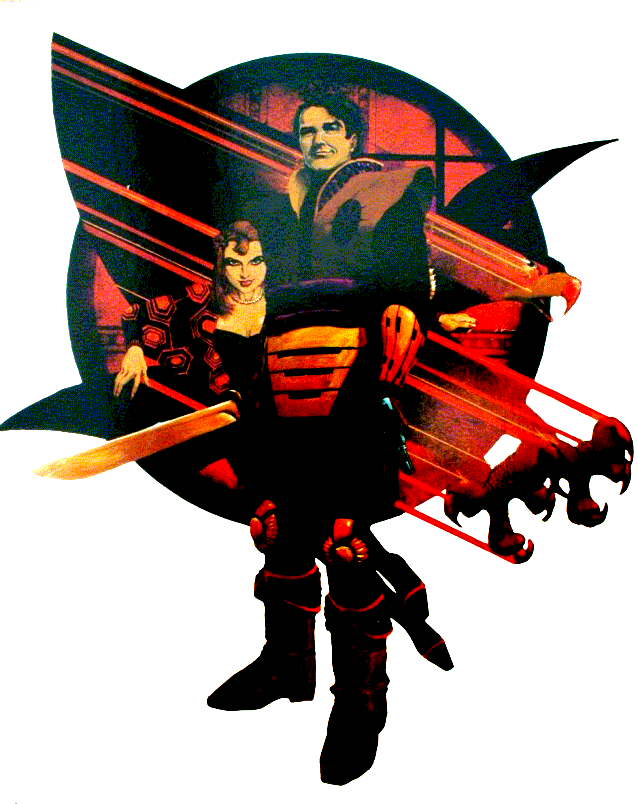 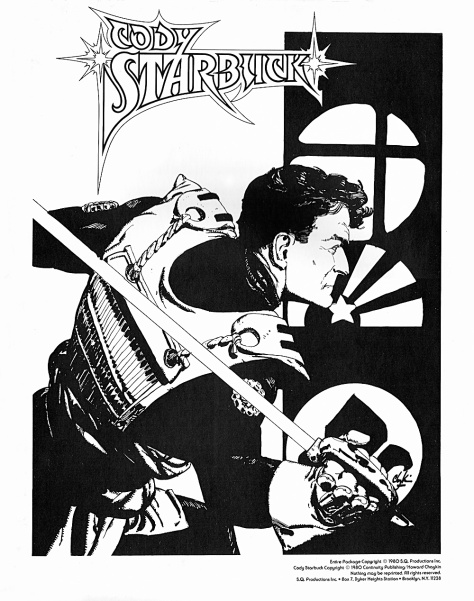 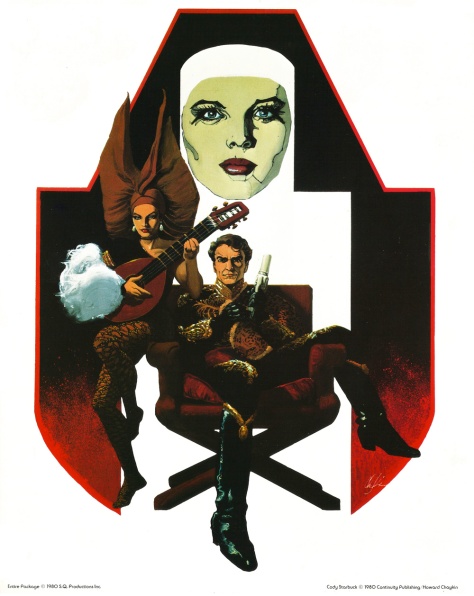 ...then as a story for Heavy Metal. 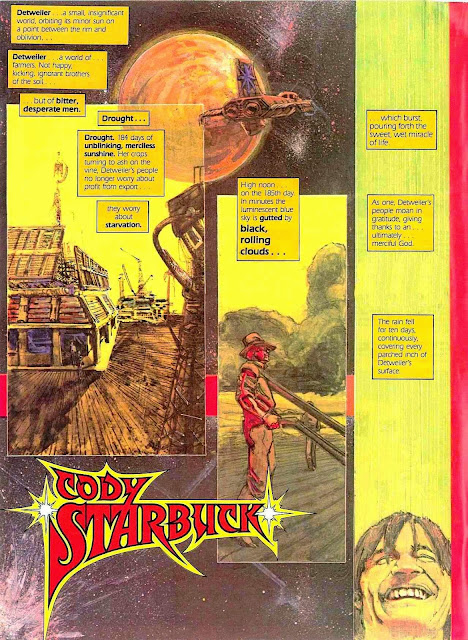 Our story finds a world with 185 days of constant sunshine, plunging it into a massive drought, until a deluge of 10 days comes, bringing death and plague with it. We are told this is one of many dying worlds, plunged into hate and combat and death, in a crumbled empire. Mercantile groups rein, controlling the limited star travel, as well as the Church crusaders and pirates. We see a mercantile world, where pirates have infiltrated their defenses. Pirates who look familiar... 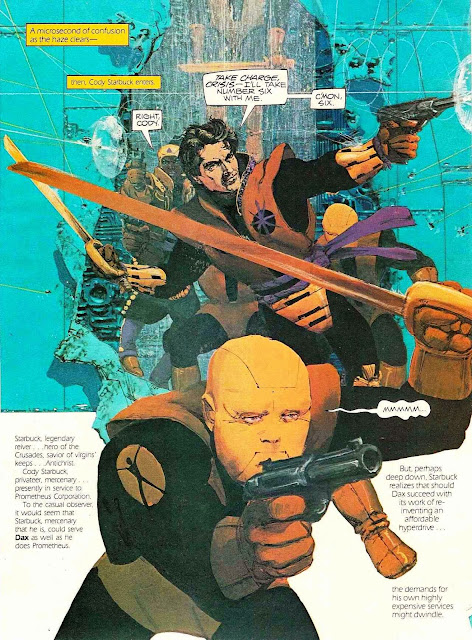 Cody is in the employ of the Prometheus Corporation, trying to sabotage the production of Dax organic space ships. His raiders include a Dronedroid, a robotic weapon, with a grenade. It is cut down before it can reach the production vats and Cody calls a retreat. 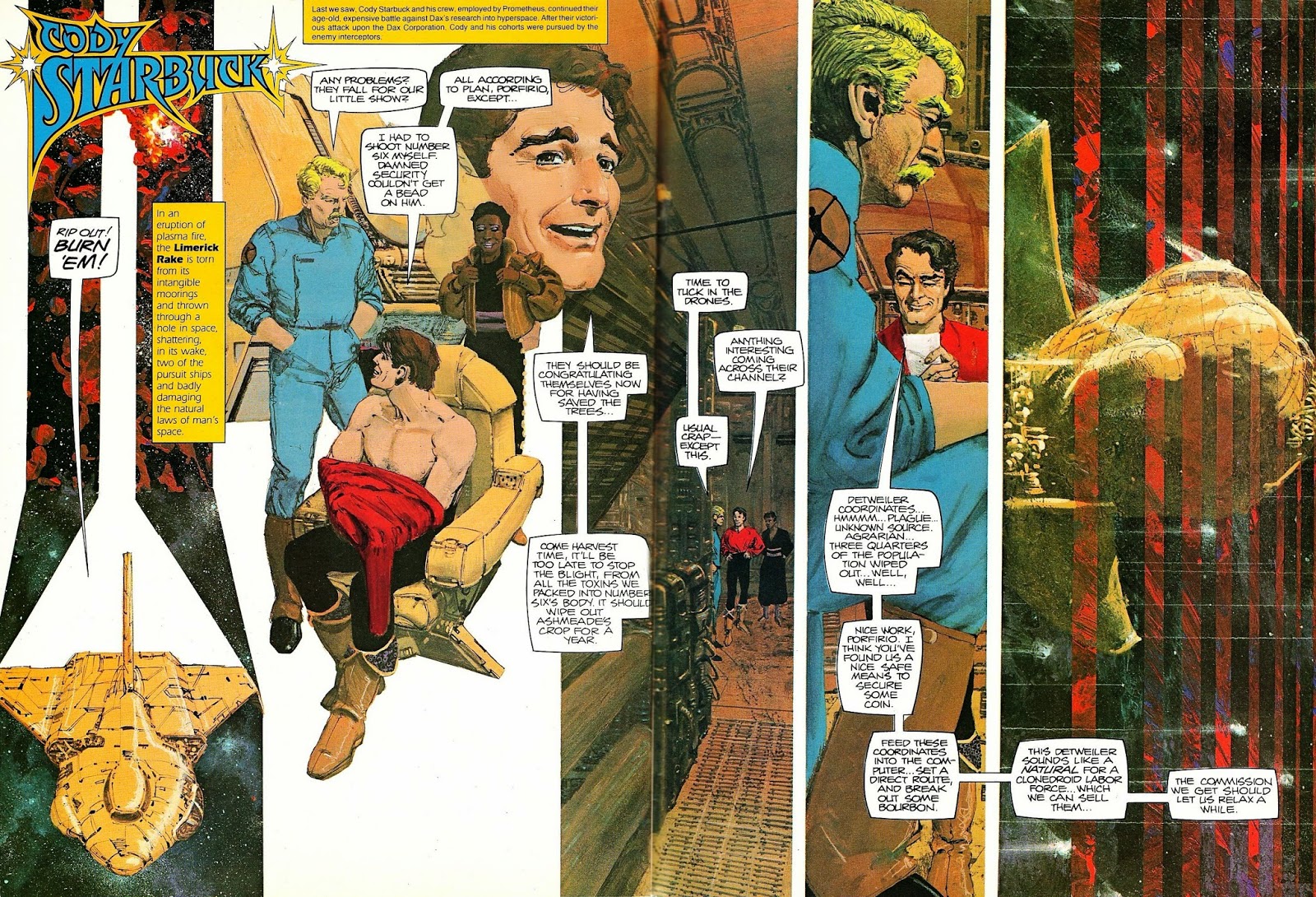 Part 2 finds Cody having escaped and revealing that the Dronedroid that failed to launch its grenade, falling inert into the vat, contained poisons that will kill the trees that can be used for organic ships, for some time to come. the Limericak Rake sets of for Detweiler, our drought world from before, to offer up drone labor, in a chance to make some coin. There, they find the Church and some local rebels, who challenge the power, out in the desert. Cody goes in search of Lady Tessa, the power on the planet, to launch his scheme. Cody lands and is presented to Lady Tessa, who seems to recognize him and orders his death. 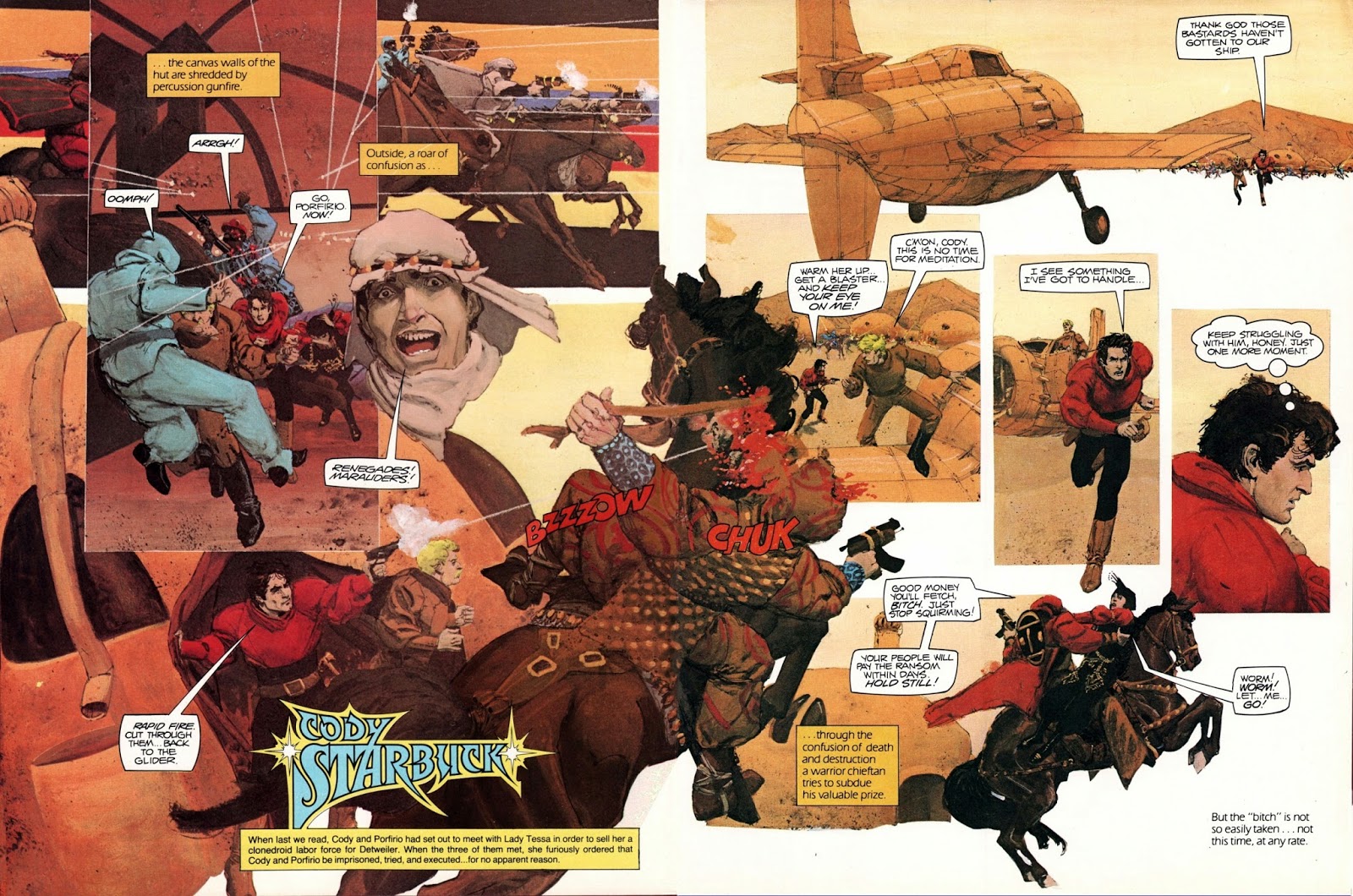 Part 3 finds the encampment attacked by marauders, allowing Cody to escape. he rescues Lady Tess from the chief raider and subdues her, as she fights and calls him a murderer. He takes her to his craft and back to his orbiting ship, where he tries to find out what she is spouting about. She says she was a Romany princess and her clan came across Starbuck and his crew, after a mission to seed the clouds. They fed them and celebrated, when Cody and his droids killed everyone and burned the encampment. Then, the deluge came. Cody finds her story preposterous, claiming to have never heard of DetWeiler until recently. he sends the princess back, safe and sound, and goes searching for his twin, who brought this destruction. 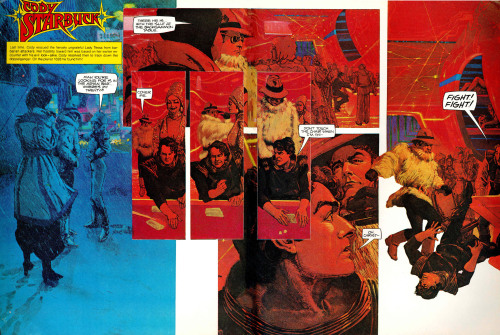 Part 4 finds Cody on planet 1062, looking for his twin. He finds him at a gaming table and introduces himself. A fight ensues. Cody kills the twin and takes the body. It is a clone, with Prometheus markings. We see Lady Rowena, head of prometheus, as she speaks to a Cardinal. Prometheus carries out wars and destruction to turn people to the Church, for which they pay them handsomely. Cody sets down on Prometheus and hails a cab, where he is informed about a bonfire, mourning for a red-headed woman who challenged Prometheus and was cut down. Cody grows angry. 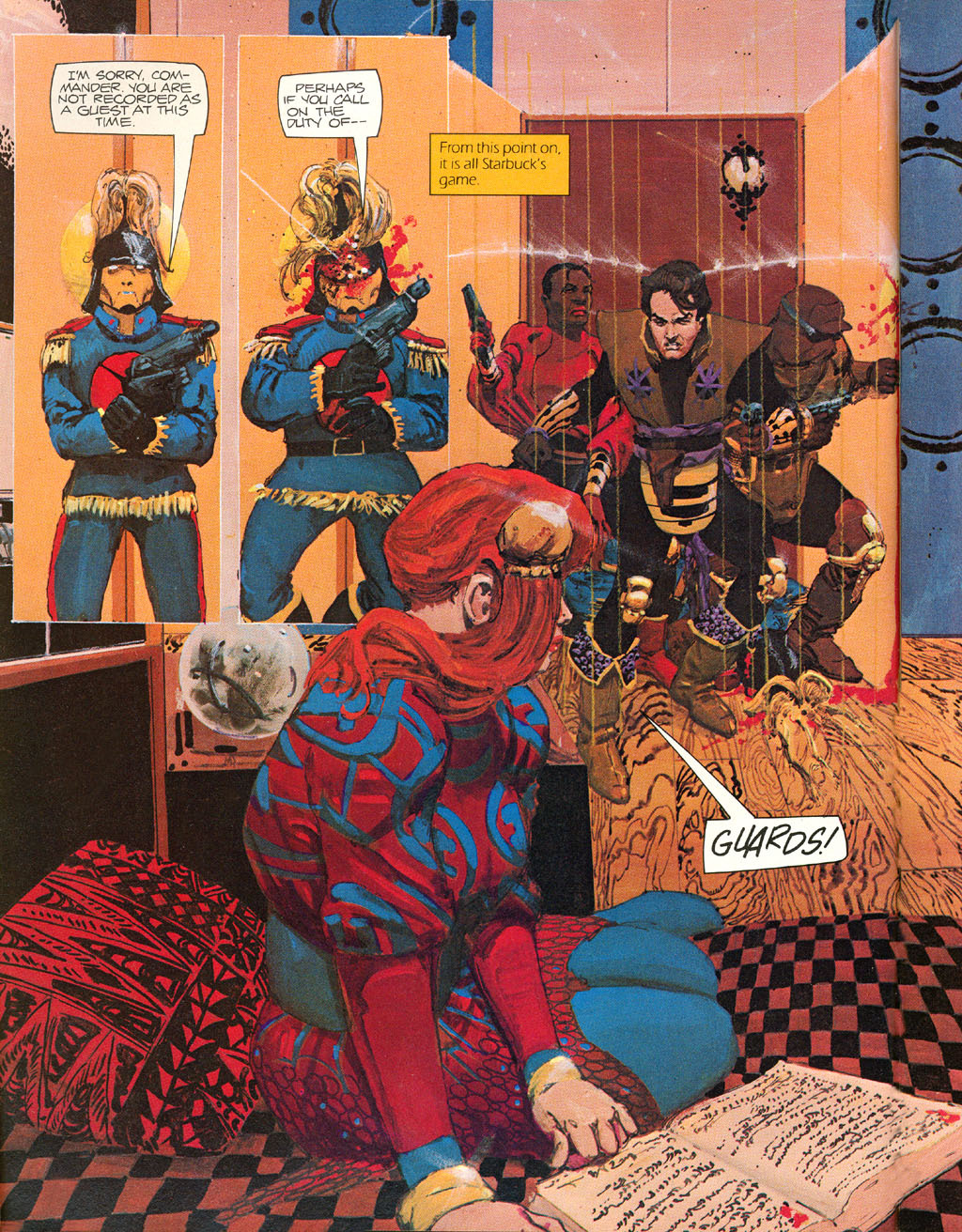 Part 5 finds Cody bluffing his way into Prometheus Crystal Palace. There, he goes after Lady Rowena and finds out that his murdered love can be cloned. he forces her to have it done, then kills her, replacing her with a reprogrammed clone. he takes the clone of his love and transports her to the mourners at the bonfire, giving them a second coming of their messiah, then departs the world. On the whole, this is a rather disjointed tale that leaves you confused with its twists and turns. Chaykin is still developing as a writer; but, it's the painted artwork that grabs you, with each installment. It is really more a collection of scenes than a story, rather like an artists portfolio. As we see with Cody Starbuck, Chaykin is experimenting with storytelling, developing his narrative voice and his amoral heroes. they are flawed men, with good and bad impulses. The earlier Cody is a bit more heroic, before becoming fully corrupt in the color special. Chaykin pulls back from that and finishes with a Cody that is a mix of the two, though more on the side of angels. None of these stories really have a continuity. Each can be taken as a variation of the theme of a galactic pirate, presenting different version of him. More than anything, it charts Chaykin's growth as an artist and a rebel. he still kept a foot in the mainstream; but, he also moved deeper into the independent world. While he did Star Wars and Dominic Fortune for Marvel, as well as Solomon Kane, Monark Starstalker, and a bit of Nick fury, he produced Scorpion for Atlas/Seaboard and collaborated on two graphic novels: The Swords of Heaven, Flowers of Hell, with Michael Moorcock, and Empire, with Samuel R Delany. he also produced his adaptation of Alfred Bester's The Stars My Destination, for Byron Preiss (completed at Epic). He then went on to create probably his greatest fully realized work, American Flagg, at First. After that, he returned to DC and the mainstream, before Hollywood came calling. He would drop by some more, before returning full time to comics. Chaykin is often confusing; but, never dull. His linework developed into a sophisticated style of his own, though with touches of Toth, taking him further from his roots in Kane and Adams. His painted work speaks of Robert Peak, illustrator of movie posters and other fine art. His writing style borrows from James M Cain, Spillane, and other crime writers, especially the cynical ones (which is most). he channels that material more uniquely than Frank Miller, making it more of his own, wallowing in sex, but with a certain self-loathing to it. His men enjoy sex; but, are often undone by it. He dabbles in porn, while Miller fills his Sin City with prostitutes and strippers; but little in the way of real sex. Chaykin isn't quite so repressed, which is probably why his comics are less violent, comparatively. He hasn't built the following of Miller; but, he has earned more artistic respect. within the pages of Heavy Metal, he stood alongside works by Corben (Bloodstar), Druillet, Crepax, Bilal and Steranko (the Outland adaptation). That is some heady company. Chaykin had the European sensibility, though built on a foundation of American comics and novels. |
|
|
|
Post by Deleted on Dec 3, 2016 23:22:26 GMT -5
Hmm, another thread that appeals to my sensibilities. Great work. If you're interested, I reviewed those Sword & Sorcery issues plus Chykin's 2 Kane issues of Marvel Premiere and a whole host of other sword & sorcery comics in my From the Sorcerer's Scroll thread. -M |
|
|
|
Post by codystarbuck on Dec 4, 2016 23:25:29 GMT -5
The Phantom #70, "The Mystery of the Mali Ibex"  One of the "other guys" was Charlton Comics. Charlton specialized in low budget comics, licensed titles, dabbled in superheroes, and did a ton of genre stuff. they had a strong line in horror and war comics; but one of their best adventure comics was The Phantom. Charlton, by far, churned out the best material for the character, in American comic books. Artists like Pat Boyette and Jim Aparo had the Ghost Who Walks fighting through the jungles of Bangalla, chasing off murderers, pirates and thieves. With issue #67, a new artist came on the feature: Don Newton. Newton was a teacher, from Phoenix, Arizona, who dabbled in comics, via fanzines. His distance from New York made it hard to break into DC or Marvel; but, he was able to submit some samples to Nicola Cuti (co-creator of E-Man) and get work at Charlton, in the horror comics. He also did painted covers for the horror and romance titles. With the Phantom, he got to cut loose, with a favorite character.  This was a cover that Newton did for the Rocket Blast Comics Collector. Newton's debut issue, #67, features a recap of the origin of the Phantom; and, specifically, the 21st Phantom, adapting Le Falk's classic story (script by Joe Gill). now, 3 issues later, Bill Pearson and Newton unleash an awesome riff on Bogart movies, with the Phantom mostly an observer. In a story right out of John Huston, we present, "The Mystery of the Mali Ibex. The story begins with the history of the Ibex statue, the last remnant of the Mali civilization; descendents of ancient Egypt. the statue was on it's way to London, in 1756, when the ship was waylaid by pirates. The Phantom interceded; but, the statue was lost. In 1886, it turned up and was sent, anonymously, to the Cairo museum. Wonder who might have done that? In 1930 the statue is stolen, in a daring robbery. In 1938, the curator of the museum receives a tip about the whereabouts of the statue, in exchange for $10,000 and decides to call in the Ghost Who Walks.  The Phantom discovers that the letter came from Malawi, where the widow of a notorious crook, Jowls Scraggs, is said to be. The Phantom doesn't believe in coincidences. Meanwhile, Rick Clifford (Bogey). Scraggs' cellmate is released from prison, in Johannesburg. He heads to Capetown, where he is reunited with his girl, Betty Ingrid, known to him as Slim (Lauren Bacall, with a little Bergman), is singing in a nightclub. He tells her of one last score. he knows where to find Scraggs' widow, to find the statue and make their fortune. The pair head off and finds Annie Scraggs, hiring her boat to head up the river, to find the Horn Cliff. This part takes us into the African Queen, as Newton copies scenes of Bogey towing the boat through thick swamps, while the two women fight. They find the cliff and talk about climbing the High Sierra, in another Bogart reference. meanwhile, Rick Clifford is being followed by two men. The Phantom is also on their trail. he catches up, thanks to the meandering nature of the river, and observes Rick diggin up the treasure. A shot rings out and hits Clifford. Scraggs tosses the statue to betty, hoping to hide it from the attackers. She runs away as the Phantom enters the fray and ends up drowned in quicksand. The Phantom gets Rick, still alive, to a friendly tribe to heal, while he follows Betty to , naturally, Casablanca. We also see the two trailing men, one of whom is the spitting image of Peter Lorre. The Phantom catches up with Betty, on a Pan-Am Clipper to Casablanca, and introduces himself as Walker and accompanies her into the city. Also in the city is Max Gratzman, aka The Fat Man (Sidney Greenstreet), owner of the Catalina Club. It is his men who have been following Rick, who is also in Casablanca. Rick sees Betty with Walker and follows. He catches up with her later. Betty says she didn't shoot him; but, thought he was dead. She has the Ibex and brings it out to show Rick. However, he realizes that he has been played for a fool, by the fat man, as he sees his men watching the alley, through the window. before he can turn around, Peter Lorre is inside and has them at gunpoint. He sends Rick out, with the case and takes them to the fat man, who finds the case empty. he orders Betty to be tortured, when the Phantom bursts in. A fire breaks out and the thieves fall apart, as Peter Lorre butts into Sydney Greenstreet, to escape... 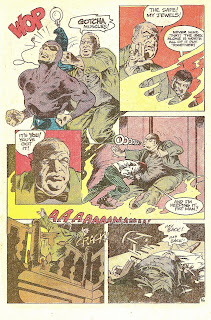 The Phantom throws a line across the alley and carries Betty out, then goes back for Rick. The fire catches up with them and burns the rope, causing them to plummet below. An awning breaks their fall. The Phantom heads back inside for the Ibex and finds Greenstreet with it; but, he realizes the writing isn't Mali and the statue is too light; it's a fake!  The Phantom (as Walker)leaves and takes Betty to a plane, where she and Rick will fly to Lisbon, to get him to a specialist, to treat his injuries. Walker bids them farewell and then confers with Claude Rains. We jump to 1976 and the Bandar have alerted the Phantom. A storm has unearthed the Ibex, in the hands of the corpse of Annie Scraggs. She had the statue all along. The Phantom returns it to Cairo, bringing an end to the journey. This story is the best of the Charlton ones and is pure fun, intrigue and atmosphere. Bill Pearson keeps it moving along, weaving together bits from The Maltese Falcon, Treasure of the Sierra Madre, The African Queen, and Casablanca. Newton gets the likenesses pretty close and his moody art really makes the story work. His art looks like a 1940s Warner Bros. movie; film noir on a page. He plays with light and shadow and fills the pages with all kinds of beauty. For my money, this is one of the single greatest Phantom stories and definitely the best of the comic books. It can be found, now, in Hermes Press' Phantom reprint, showcasing Don newton's run. The actual comic goes for reasonable prices, in grades below very fine (and good luck finding a Charlton in anything above Very Good. They didn't use top-flight paper). This should have been the plot for the Phantom movie. Heck, any of the Newton stories is perfect fodder for a movie, including the last issue, featuring the Phantom aiding Ben Franklin, on the eve of the signing of the Declaration of Independence.  |
|
|
|
Post by Deleted on Dec 4, 2016 23:46:57 GMT -5
I had a couple of random Charlton comics as a kid (Emergency, Six Million Dollar Man) that were favorites form TV but didn't really "discover" until a few years later in the summer of '77 when I got a bunch of the polybag 3 packs of Modern Comics reprints of a lot of classic Charlton stuff. I really dug a lot of those (though the lettering style bugged me even as a kid). I didn't discover the Charlton Phantom series until much later however, and I have only recently started hunting down some of these. I did pick up that final issue at the last show I attended back in October though.
-M
|
|
|
|
Post by codystarbuck on Dec 5, 2016 0:04:33 GMT -5
I had a couple of random Charlton comics as a kid (Emergency, Six Million Dollar Man) that were favorites form TV but didn't really "discover" until a few years later in the summer of '77 when I got a bunch of the polybag 3 packs of Modern Comics reprints of a lot of classic Charlton stuff. I really dug a lot of those (though the lettering style bugged me even as a kid). I didn't discover the Charlton Phantom series until much later however, and I have only recently started hunting down some of these. I did pick up that final issue at the last show I attended back in October though. -M I had one or two of those Modern Comics polybag sets. Charlton wasn't easy to find in the wild. Phantom 66 was the first I ever had (just before Newton took over) and I found #70 a bit later. My cousing had a Blue Beetle and a Peter Cannon, plus a bunch of the horror comics, and a neighbor had one or two of those. I got E-man #1 in a Modern Comics set; and, later found the Charlton original printing, and got it signed by Joe Staton. Their distribution was so spotty, you never knew if you would find them in the same place twice. It seemed like their Hanna-Barbera stuff was easier to come by. Point of trivia: John Byrne's early Charlton work included Wheely and the Chopper Bunch! |
|
|
|
Post by mikelmidnight on Dec 5, 2016 12:47:55 GMT -5
I was a huge fan of the Star*Reach line from its inception, and I still consider it a high-water mark for comics. The Cody Starbuck tales might do well as a collection, although I'm fairly sure the stories have no continuity at all, which might work to its detriment.
Although if I had to pick one continued story from the line for a collection, it'd be Stark's Quest.
|
|
|
|
Post by wildfire2099 on Dec 5, 2016 13:25:11 GMT -5
I had no idea Cody Starbuck was a character ... looks really interesting!
|
|
|
|
Post by codystarbuck on Dec 5, 2016 14:03:22 GMT -5
Star*Reach had some really great stuff, like Cody Starbuck, Stark's Quest, Parsifal and The Sacred & the Profane. The latter got the most mileage. It was serialized across Star*Reach, reprinted in Epic Illustrated, and then collected into a graphic novel by Eclipse. Friederich also published some other books, like Imagine and Quack, which was a more humor-oriented magazine, with people like Steve Leialoha.
There is pretty much no continuity between the Cody Starbuck stories, which may be why they have never been collected. I am surprised that the Heavy Metal story was never released as a collected album. Chaykin pretty much wrote each of them as if the previous one never existed. Even visually, there is little continuity, though that is as much Chaykin evolving as an artist. I suspect the first one was approached more as a revamping of Ironwolf and the second to try to do something more original. The color special was a total departure, pushing the character into darker territory. The Heavy Metal one seems to pull back from that and try to mix elements of the color special with the earlier, more heroic tales. It's definitely more of a blend of the approaches. I get the feeling that Chaykin may have been consciously trying to work more in the European style. Funny thing is, he has trashed the Europeans as much as the Americans, though he is always rather tongue-in-cheek about it and always points to a lot of his own material as being crap (especially the earlier stuff).
|
|
|
|
Post by mikelmidnight on Dec 6, 2016 13:10:19 GMT -5
Friederich also published some other books, like Imagine and Quack, which was a more humor-oriented magazine, with people like Steve Leialoha. Not to mention Pudge, Girl Blimp! More than likely Chaykin simply likes the name 'Cody Starbuck' and attaches it to random space operas he wants to tell.  But yeah, that would make a collection of the stories rather perplexing, enjoyable as they are. |
|
|
|
Post by MDG on Dec 6, 2016 15:44:43 GMT -5
More than likely Chaykin simply likes the name 'Cody Starbuck' and attaches it to random space operas he wants to tell.  The same way the lead character in a lot of his work is the same guy, whether he's called Cody Starbuck, Dominic Fortune, Ruben Flagg, Blackhawk, Cass Pollack, or whatever. While sometimes I feel his storytelling peaked with Flagg! (which might just have been a case of the right book at the right time for my state of mind) Chaykin is one of the best and thoughtful artists to come out of the 70s. |
|
|
|
Post by Prince Hal on Dec 6, 2016 16:48:49 GMT -5
codystarbuckNice review of the Mali Ibex story, Cody. That and the Ben Franklin story (the final Charlton issue, I think), whose cover you show, are my two favorites of Newton's Phantom run. Hell, two of my favrite comics, period. It was such an unexpected pleasure to pick up a Charlton comic that was done with such loving care. Such a great concept to use a different era's Phantom to share an adventure with Ben Franklin. No time travel issues, no chessy S/F Maguffins. So simple. My only complaint about each was a typical one: the lousy Charlton paper and printing. But beggars couldn't be choosers... No idea if either of these has ever been republished and decently printed. That drawing of S.Z. "Cuddles" Sakall (Carl the head waiter in Casablanca) in the second panel of the first page is dead-on, btw.
|
|
|
|
Post by codystarbuck on Dec 7, 2016 2:23:17 GMT -5
More than likely Chaykin simply likes the name 'Cody Starbuck' and attaches it to random space operas he wants to tell.  The same way the lead character in a lot of his work is the same guy, whether he's called Cody Starbuck, Dominic Fortune, Ruben Flagg, Blackhawk, Cass Pollack, or whatever. While sometimes I feel his storytelling peaked with Flagg! (which might just have been a case of the right book at the right time for my state of mind) Chaykin is one of the best and thoughtful artists to come out of the 70s. I'd tend to agree with that, as far as Chaykin as a solo. I'd say the writing in American Century, which was a partnership, was as good, if not better, in some ways. American Flagg was the culmination of Chakin's evolution from ironwolf, to Cody Starbuck, to The Scorpion, to Dominic Fortune, to Monark Starstalker, to Reuben Flagg. I do think Chaykin captured lightning in a bottle, as it fit the 80s so well, yet seemed so far ahead. |
|
|
|
Post by codystarbuck on Dec 7, 2016 17:36:43 GMT -5
         So, let me introduce you to the world of Patty Cake, by Scott Roberts. The comic was published in various locales, such as Roberts' own Permanent Press, Caliber (under their Tapestry line), and Slave Labor Graphics. It features delightful tales of a cute little girl, Patty, and her friends and family. Patty is a kid, filled with enthusiasm, a playful sense of anarchy, a clear vision that the world is unfair to little kids when it comes to stuff they want, and the rock solid belief that what she says is true, at the time she said it; but, new events cast it in a different life (like facts and logic). In other words, a real kid. Roberts captures the joy and fun of childhood, from a child's eyes, much like Bill Watterson did with Calvin and Hobbes. Patty has an older sister, and her friends Irving and Jose. Irving is the dimmer of the two, who usually gets suckered into Patty's flights of fantasy and hijinks. Jose is a bit more on the ball and still gets caught in the havoc. You can sample the book here, at Scott Robert's website (it's a bit old; but, filled with fun): www.oklahoma.net/~silvrdal/patread.htmlWhat sets it apart from cute kid comics, like the old Harvey comics or stuff like the Family Circus is that it has a sharper satirical edge to it; yet, never loses sight of real warmth and heart. In that, it follows in the traditions of Peanuts, the Simpsons, Calvin & Hobbes, and strips like For Better, For Worse. I stumbled across the series in the 90s, when I was tired of superheroes punching each other in events and looked for more alternative material. I had been reading a lot of independents, since college; but, most tended towards action and adventure genres. At this point, I started discovering a lot of other voices, like Martin Wagner on Hepcats, Terry Moore's Strangers in Paradise, Peter Bagge's Hate, Terry Laban's Cud and Eno & Plum (characters from Cud), and Caliber's Negative Burn anthology. Along the way, I saw a solicit for patty Cake, in Previews, and thought it looked kind of cute; so, I gave it a go. And, I loved it. Most issues have a couple of short pieces; most silly, a lot heart-warming, all fun. The one I truly love, and wish I had scans of, is the Christmas Special. The story finds young Patty in the Fall, less than happy. She has homework and stuff, which weighs her down. School isn't fun stuff, at her grade. We see someone yell "gang 'way" as Jose is carried through, unconscious. He has collapsed under the weight of his homework. Being the Fall, the retail world is gearing up for Christmas and the new Sel-More catalog has come. As every child does, Patty snatches it up and looks at the season's new toys and finds the perfect one: the Monkey Playground. Only $399.95! That's it, the perfect gift and she wants nothing else. She tells everyone, only to be greeted with much less enthusiasm and outright cold water. It's too expensive. i'll ask Santa! (Yeah right, you do that, kid.) So, we see Patty's attempts to tell Santa. She is interrupted in the long line for the mall Santa, gets put on terminable hold for Santa's hotline, then forgets to ask for the toy, writes a letter and other attempts. Meanwhile, her dad, a shop teacher, has designed the perfect little rocking chair for his little girl. He picks out the best wood for it, sands it, planes it, and slowly builds that chair with his own two hands. This isn't some plastic junk that will be broken in a couple of days. This is something special, that will last a lifetime. He pours his love and soul into that chair, while his little girl blabbers on about monkeys. Finally, the day comes. It's Christmas! (technically, given the hour). Time to rip open presents! "After breakfast!" "Aw, no fair..." After a quickly gulped breakfast, it's time for presents. There's a big one that has to be the monkey playground. Patty has to wait, and wait. She gets a cool Snap Dragon puppet, as seen on tv, which she really likes. But, there's the big one. finally, it is time. She rips it open and finds.......... a chair................a little dopey chair! Ralphie got all the breaks. No Old Man nostalgia here. Patty is mildly disappointed. Okay, she throws a fit and screams and yells. She ignores her father's attempts to tell her that it is a special chair. She storms off, saying they don't love her and sulks in her room. Her father stares down at the little chair, tears in his eyes. Eventually, her mom comes to her room and talks to her. She tells her that they told her they couldn't afford the Monkey Playground. That the chair didn't come from some store, that her father designed it, picked the wood and built it, because he loves his little girl more than anything. She tells her that her father cried and he has only done that one other time, when Patty was born, and he was crying because he was happy, then. Patty cries, herself. We see her father sitting alone, in a darkened room, listening to Christmas music. Patty comes into the room and looks at the chair, as a song talks about what gift to give "him" when I have little; all I can give is my heart. Her father is awakened by a creaking noise and looks down to see Patty rocking in her chair. She smiles up at him and says "Thank you, Daddy!" He cries for the third time. The next day, Patty is talking to Irving and Jose. Irving got the Monkey Playground and it isn't all it's cracked up to be, and it's broken. Jose disses the chair and Patty says it is cool, something she can treasure her whole life. Jose says, "Hah! With your skinny butt, you'll probably fit in it your entire life!" Patty plasters him with a snowball and yells, "Be Nice, Jose!" Jose, covered in snow, responds, "Happy New Year, ya little maniac!" Patty replies, "Thanks, you too." The story finishes with a note from Scott, how his father, who passed away just after his 78th birthday, once made a wooden Popeye toy for him. He treasured it into his adulthood and was able to tell his father that, before he died. The issue is dedicated to his father. The beauty of that issue is stunning. It is a tale worthy of Charles Schulz, O Henry, Dickens or any of the other masters of heart-felt Christmas stories. It captures the spirit of gift giving and the perspective of childhood, without letting sentiment overwhelm it. It also adds a bit of biting commentary about the commercialization of the season and the quality of most "must have" toys. Patty Cake is a series that you can jump into with any issue. It's filled with such fun and warmth and is something you can gleefully share with your kids, or anyone who is still a kid at heart (we need more of them). There is a color collection out there, available for reasonable money, and the issues are certainly affordable. Give it a try and share the fun. |
|
|
|
Post by hondobrode on Dec 8, 2016 0:48:35 GMT -5
codystarbuck Nice review of the Mali Ibex story, Cody. That and the Ben Franklin story (the final Charlton issue, I think), whose cover you show, are my two favorites of Newton's Phantom run. Hell, two of my favrite comics, period. It was such an unexpected pleasure to pick up a Charlton comic that was done with such loving care. Such a great concept to use a different era's Phantom to share an adventure with Ben Franklin. No time travel issues, no chessy S/F Maguffins. So simple. My only complaint about each was a typical one: the lousy Charlton paper and printing. But beggars couldn't be choosers... No idea if either of these has ever been republished and decently printed. That drawing of S.Z. "Cuddles" Sakall (Carl the head waiter in Casablanca) in the second panel of the first page is dead-on, btw. I see Hermes Press has reprinted Charlton's The Phantom in 5 hardcovers, collecting the entire Charlton Phantom series and presented in the 7.5" x 10" hardcover with dustjacket, end papers, digitally recolored work, articles, etc. 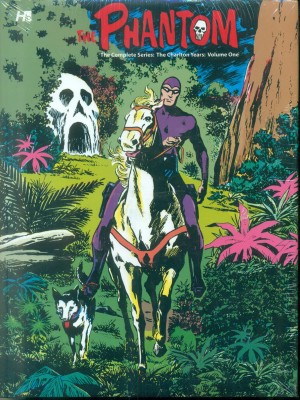 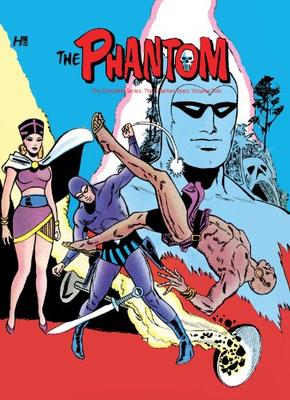 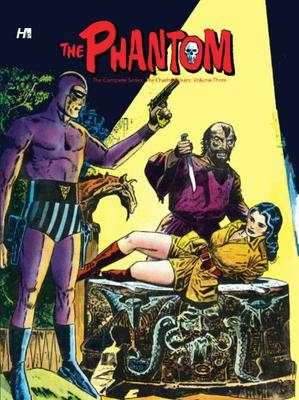 There are two more volumes but I couldn't get decent pics. These are around $ 50 each, but I've seen them as low as $ 35 each, so there ya go. Hermes Press is also reprinting the Phantom strips, and the Gold Key Phantom. |
|







 F
F















 F
F










































